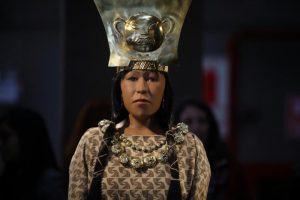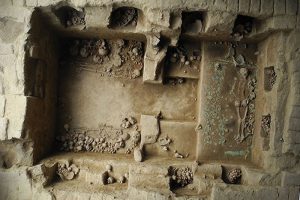When most people think of archaeology, the picture that comes to mind is more-often-than-not one closer to that of Indiana Jones than to that of Lara Croft. Despite both characters existing on a fictional spectrum, this observation of how such popular media culture is represented and absorbed by the general public is an example of a much bigger problem within the field of archaeology itself: androcentrism and the male bias.
Excavations of the Moche civilization in San José de Moro, Peru that inhabited the area between 1 CE and 800 CE have been taking place for decades. But in the past 27 years, up to eight notable tombs have been discovered in what was once thought of as a society consisting of only male warriors, priests, and kings. Tomb after tomb, archaeologists’ preconceived notions of the civilization’s societal composition were put to the test and quickly fell apart. In 2006, archaeologists were shocked to come across a lavishly decorated tomb on the El Brujo site filled with the remains of—you guessed it—a woman. The findings from a burial analysis of her mummified skeleton and the artifacts deposited in her grave—buried with wooden scepters wrapped in copper, a large crown with an image of a puma, and several tattoos symbolizing sacred figures including snakes, spiders, trees, and stars—led archaeologists to believe that she lived as a high priestess or even a queen of the Moche people. She was later referred to as the Lady of Cao, her burial’s discovery only to be followed by seven additional discoveries of other burial sites of women. The mummies adorned extravagant headdresses and beaded necklaces, were buried next to sacrificed victims, and were surrounded by grand artifacts including scepters and goblets that indicated that they, too, were of higher status and had possessed a more prominent role in the Moche society.

A reconstructed 3D-printed replica of the face of the Lady of Cao, a female priestess-queen of the Moche civilization.
The impact of androcentrism in archaeology is thoroughly and explicitly exemplified in the long-held assumption by archaeologists that the Moche society was ruled only by male figures; with further analysis of the burial sites, findings implied that the buried Moche women belonged to a higher social class, further breaking the notion that the Moche civilization exclusively comprised of higher orders of men and, rather, included—or more often comprised of—women as social elites.

The tomb of the eighth Moche priestess to be discovered, buried 1,200 years ago with an array of artifacts that indicates her high social status.
The discoveries of the priestess-queens of the Moche remind us that we must stay aware of our presumptions and biases as they often bring us to incorrect conclusions. As archaeology is still developing when it comes to including, recognizing, and rewarding women, the male bias is especially important to keep in mind when considering historical archaeological conclusions about the role of gender in ancient societies and cultures. With an awareness of the biases of not only ourselves but also those of archaeologists before us, we can make sure that we are not discounting any potentialities on a matter of assumption or misinterpretation of evidence and that we are, instead, taking into consideration all possibilities in order to accurately restore the archaeological record.
Sources
Renfrew, Colin, and Paul Bahn 2010 Archaeology Essentials. 2nd ed. Thames & Hudson, New York.
Excavated Tombs of Peru’s Moche Priestesses Provide Archaeologists with Troves of Artifacts, Data
Lady of Cao Comes to Life: Face of Peruvian Priestess Reconstructed from 1,700-Year-Old Mummy
The Lady of Cao and the Royal Tomb Images Source
Additional Readings
Tomb of a Powerful Moche Priestess-Queen Found in Peru
1,500-year-old Ruins Shed Light on Peru’s Mysterious Moche People


Thinking about bias is always a good thing, especially in anthropology. It’s something we always consider and question, sometimes to the point of self-flagellation. I wanted to ask more about your initial statement–that within popular culture, there is an image of archaeology that is rooted in this androcentric masculinity or, when a woman is in the picture, the image is one of hyper-sexuality within the male gaze. Also, both of these actors and representations are that of white explorers. And, above all, the idea of archaeology is that it is treasure hunting. How do we move beyond these narratives of a white, male-centered, treasure-hunting archaeology? Do you think this would be beneficial, why or why not?
The field itself has a long way to go when it comes to encouraging the pursuit of archaeology as a career among non-whites and the inclusion of diversity among all ethnicities (Dave 2016). Looking at the Chartered Institute for Archaeologists’ publishment of their yearly report “Profiling the Profession,” surveys have shown that over 99% of the archaeological workforce in the UK is made up of white-identifying individuals, leaving only a mere 1% as “other” ethnicities (Aitchison 2003). Why is there such a lack of racial diversity within the field—could it have anything to do with the way archaeologists have been depicted for years and years? By looking at the age bands of the archaeological workforce separated by men and women, measurements based on these figures have shown that there are nearly an equal number of—if not actually more—women than men working in the field of archaeology (Lazar et al. 2014). So why is it that in popular culture, we’re much more likely to see a man represented as an archaeologist than a woman? Even with some of the most famous pop culture figures featuring women as archaeologists, like the acclaimed Tomb Raider, characters like Lara Croft were spotlighted simply to be sexualized and to satisfy the male gaze—because what is a woman hero if she isn’t wearing skin-tight clothes and sporting unrealistic body proportions? With the recent debut of the new, coming-of-age version of Lara Croft in Alicia Vikander’s Tomb Raider—where less focus is put on Lara’s body and more on her exploration and adventure—we as a society are slowly making small strides to be more encouraging of including diversity—both in gender and race—and more encompassing of the real numbers behind the field of archaeology, but we still have a long, long way to go (Aitchison 2013). We must move away from these olden, damaging narratives of a white, male-centered, treasure-hunting archaeology that skew the perception that so many in the general public have come to believe to be real archaeology. The difference between treasure-hunting and archaeology is one that has been long-debated, treasure-hunters searching only for a quick profit off of marketable artifacts whose careless excavations destroy the information that archaeologists search for when analyzing sites to learn more about the history of the humans that once lived there from their remains and artifacts. To keep archaeology a growing and inclusive field, it is necessary to move past these androcentric ideologies we have so long been fed about archaeology (Dave 2016). We must start to create—and start to demand—more accurate and diverse depictions of archaeologists and archaeology itself in popular media—films, TV shows, and video games alike—in order to better portray today’s modern archaeologists and better inform the coming generations of new soon-to-be archaeologists.
Dave, Raksha
2016 Archaeology must open up to become more diverse. Guardian. Electronic document, https://www.theguardian.com/culture-professionals-network/2016/may/23/archaeology-must-open-up-become-more-diverse, accessed October 20th, 2018.
Aitchison, Kenneth and Rachel Edwards
2003 Archaeology Labour Market Intelligence: Profiling the Profession 2002/03. Cultural Heritage National Training Organisation, Little Bradford, West Yorkshire, ENG.
Aitchison, Kenneth
2013 Archaeology Labour Market Intelligence: Profiling the Profession 2012-13. Landward Research Ltd., ENG.
Lazar, Irena, Tina Kompare, Heleen van Londen, and Tine Schenk
2014 The Archaeologist of the Future is Likely to be a Woman: Age and Gender Patterns in European Archaeology. Archaeologies Volume 10 (No. 3): page 257.